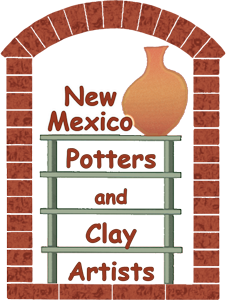 The annual New Mexico Potters and Clay Artists workshop occurs August 22 through 24 this year. In the long tradition of NMPCA renting space at Ghost Ranch for workshops beginning as far back as early 1980s, we look far and wide for ceramics teachers.
The annual New Mexico Potters and Clay Artists workshop occurs August 22 through 24 this year. In the long tradition of NMPCA renting space at Ghost Ranch for workshops beginning as far back as early 1980s, we look far and wide for ceramics teachers.
After reviewing potential presenters over the winter months, the Workshop Committee picked Sarah Wells Rolland of The Village Potters Clay Center in Asheville, NC. Sarah will add the fees we pay her to the larger fundraiser to rebuild their 14,000 sq. ft. facility that was destroyed in the flood caused by Hurricane Helene last September. Her teaching (alongside George Rolland and Karen Dubois of The Village Potters Clay Center) will include a public presentation in Santa Fe at Paseo Pottery the night after the workshop. This multi-faceted gig in New Mexico is the last one in a string of 14 in nine states, all happening in a planned Workshop Tour starting just this year in 2025.
The workshop is full at Ghost Ranch, but the Monday evening event (August 25th) with throwing demo “Exploring Pots for the Woodfire Aesthetic” and presentation “The Kazegama Kiln: Construction, Firing, Wood and Soda Ash” still has room for a big crowd at Paseo Pottery, 1273 Calle de Comercio, Santa Fe. There is no fee associated with the event. Donations are encouraged with all proceeds going to the recovery of their center, and can be made online through NMPCA or directly to The Village Potters. Donations at the event can be made by cash, check or credit card. You can reserve your spot on the NMPCA website. An online raffle of four ceramic works, with a piece by Sarah Wells Rolland of The Village Potters Clay Center, will be added to the event.
Sarah Wells Rolland answered the following questions for The Slip Trail recently.
1. Please tell us briefly about Village Potters Clay Center’s history and your tenure and role there.
Sarah Wells Rolland (she/her) and her husband George (he/him) co-founded The Village Potters in 2011. Sarah currently serves as President of the Center, leading both the administrative and teaching/mentoring staff. George, Vice President, oversees all facilities operations that includes building, maintaining, and repairing the infrastructure that supports the center’s daily function.
In addition to being a thriving creative hub, The Village Potters also is a clay supply company. Sarah works closely with the clay company administrator to support our communities clay, tools and glaze material needs.
Sarah has her personal studio within the center. She devotes most of her time to teaching and mentoring aspiring potters both locally and across the US, focusing on intermediate to advanced ceramic techniques, business development, and helping artists discover and refine their personal aesthetic. She regularly teaches both online and weeklong workshops.
Sarah’s distinctive and evolving body of work is exhibited and sold exclusively at The Village Potters Clay Center Gallery. Although she spent more than 25 years selling her work in galleries nationwide, she now chooses to offer her work solely through the Center. To learn more about their loss and recovery, visit website.



From left to right: Sarah Wells Rolland, Karen Dubois, George Rolland. Photo credit: Village Potters Clay Center.
2. The Village Potters Clay Center’s mission connects with how many potters and ceramic artists in your region?
The Village Potters primarily serves adults in Asheville, Western North Carolina, and Eastern Tennessee, while also welcoming visitors and artists from across the U.S.
Our programs and facilities support a diverse and growing community, including:
- 25 displaced professional ceramic artists who will return to permanent studio space when we reopen in October.
- 14- 18 emerging artists enrolled in our Advanced Studies Program, built on independent study and mentorship. In this nationally unique program, designed to nurture and raise up the next generation of potters. Seasoned professional staff mentor the students in honing skill, creating a unique body of work and business in the arts.
- Over 100 community members study with us weekly who participate in pottery classes for all skill levels.
- More than 1,400 regional potters who rely on us for access to clay, tools, and essential ceramic supplies.
- Local and national visitors shop in our contemporary ceramic gallery, supporting artists through direct sales.
- Artists from across the country travel to Asheville for our weeklong intensive workshops and educational events.
Through these already established offerings, we support the creative, educational, and professional needs of ceramic artists at all stages of their journey.


Left to right: Sarah Wells Rolland studio at the Village Potters Clay Center, before and after flood. Photo credit: Village Potters Clay Center.

Village Potters Clay Center aerial view after flood. Photo credit: Village Potters Clay Center.
3. In the 9 months since the river flooded after the hurricane, destroying all the many aspects of your facility, tell us the story of the progress happening so far.
On September 27th 2024, Hurricane Helene caused catastrophic flooding that devastated The Village Potters Clay Center with 26 feet of water. Our studios in the River Arts District were overwhelmed, and we lost almost everything, 16 kilns, tools, infrastructure, equipment and we no longer had a facility for our vibrant community of ceramic artists and students.
When the waters receded, we removed all the equipment we could and began a cleaning, repairing and restoring project at a donated apple barn. This is still ongoing. We have restored over 37 wheels, 4 slab rollers and other equipment. However, all our 17 kilns were lost but one, the Kazegama kiln, which was built on a trailer, so we drove it out of the flood area before the waters came.
We have acquired a new facility that is 18,000 sq feet and out of the flood plain but only .8 miles from The River Arts District. We are currently upfitting this facility with a budget of $200,000.
In the wake of this disaster, we were humbled by the outpouring of support from our community near and far. That support gave us the strength to begin again, not only to rebuild but to reimagine the future. As we recover, we are establishing a 501(c)(3) nonprofit, The Village Potters Foundation, to ensure the legacy of our mission.
Our Foundation’s Mission: The Village Potters Foundation is dedicated to preserving the legacy of fine craft, inspiring passion, nurturing growth, and supporting sustainable careers for the next generation of clay and ceramic artists.
The Foundation will sustain our educational programs and gallery, support working ceramic artists who have been displaced, and help offset the exponentially higher costs associated with relocating to a new space in Asheville. Our goal is to provide subsidized studio spaces for up to 25 artists and to reopen our full educational programming, clay supply company and gallery operations.
We currently project a soft reopening in Sept 2025, with educational programs resuming shortly after. Our Grand Reopening Celebration is planned for October 11th with a fundraising event on Oct 9th, “The Shape of Resilience: An evening of Hope and Renewal”.

Photo credit: Village Potters Clay Center.
4. In your slide show presentation, you share a special kiln, designed in California, that has graced your complex since 2016. What state is this kiln in now? Was it damaged in the flood? Tell about its popularity and how much it’s being used after the flood.
The Kazegama kiln was born out of our desire at The Village Potters to merge the soulful beauty of wood fired and soda fired pottery with the practicality of a modern studio practice. Constructed by George Rolland of Rolland Kilns and Potter Karen Dubois, the kiln was originally designed by Steve Davis of Aardvark Ceramics in California. George and Steve talked extensively during the construction of this kiln.
Since our first firing in Oct 2016 this kiln has had many modifications to perfect its firing results, as well as efficiency in fuel usage. George modified the kiln to meet our needs changing the liner to accommodate soda ash, which is highly corrosive, and changing the burner system to passive burners as well as changing the way we introduce wood ash and soda ash to insure action and beauty in all areas of the loading chamber.
Kazegama, named by Steve Davis, means “wind Kiln” in Japanese. Our modified kiln is fired with natural gas to cone 9 (2230-2300 degrees Fahrenheit) and then screened wood ash is blown into the atmosphere of the kiln through ports we created around the perimeter. Then we bring the kiln back up to temperature, cone 9, and spray soda ash in the kiln through the same ports
We surrender our pots unglazed to the fire and ash. The flame moves through kiln creating the magic, lighting wood and soda ash on the surfaces of the pots, leaving behind subtle flashes, warm blushes, and glaze effects that are both beautiful and unexpected.
Today, the Kazegama kiln, which was our only kiln to survive the flood, is a centerpiece at The Village Potters Clay Center, where it serves both as a teaching tool and a vessel of exploration for potters who seek that elusive balance between control, surrender and spontaneity. It represents innovation rooted in tradition and is an invitation to surrender and celebrate its magic together. This kiln creates friendships, relationships and community. We are so thrilled it survived the flood.



Views of Karen Dubois and George Rolland retrofitting the Kazegama kiln. Photo credit: Village Potters Clay Center.
5. How many places are you visiting on your Recovery Fundraising Tour?
During my fundraising 2025 Workshop Tour I have offered 14 workshops and traveled to nine states. I have one workshop left on the tour at Ghost Ranch in New Mexico. My workshops include a Slide Presentation and Talk about our beloved center, our mission, our loss and our recovery.
I have met over hundreds of wonderful potters across the country and have felt the amazing support and compassion for our challenges.
After coming to Ghost Ranch and Santa Fe I plan to put all my focus on our reopening in early October, and begin having my workshops again at our new location in Asheville.



Collaborating organizations.
---
If your curiosity is piqued, please join in the throng on Monday, August 25th at Paseo Pottery!
Heartening to remember the effort by Taos Ceramics Center in 2024 that raised over $10K from New Mexico to aid potters in North Carolina via CERFplus .
It will be interesting to share the story of Pot Hollow at Ghost Ranch which flooded ten years ago, being rebuilt this summer, with these folks from Village Potters Clay Center, when they are at Ghost Ranch.
-the editor.


